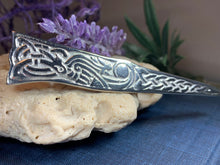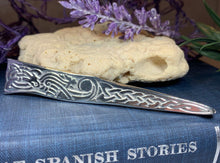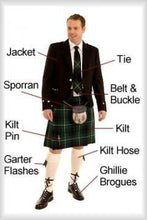
Description
TAKE AN ADDITIONAL 20% OFF THE ALREADY REDUCED SALE PRICE - ADDITIONAL 20% IS DEDUCTED AT CHECKOUT with code SAVE20
This beautiful kilt pin is in the traditional design of a stylized Celtic dog with the twists and turns of a Celtic knot.
A strong pin to handle any kilt apron or tartan - also perfect for any coat, sweater or shawl.
3 3/4" x 3/4" in highly polished pewter - will not tarnish or rust.
Kilt pins are NOT just for kilts! This pin is made with an extra strong pin to handle thicker fabrics - making it the perfect pin for coats, jackets, skirts, hats or anywhere else a pin would look beautiful. It is a great pin for a ladies cape or ruana wrap!
How and why do I wear a kilt pin?
Ever since Queen Victoria reputedly used her hat pin to secure her kilted skirt modestly on a blustery day, a kilt pin has been worn with a traditional kilt. Its style is entirely a matter of your personal choice. It should be on the right hand side of the kilt, pinned through the front apron only (to prevent tearing) about 4 inches from the bottom of the kilt and 2 inches in from the fringe.
PEWTER Made of solid lead free pewter -
Pewter has been used in jewelry making for pewter does NOT RUST OR TARNISH and will last a lifetime. Pewter was used for decorative metal items in the Ancient World by the Egyptians and later the Romans, and came into extensive use in Europe during the Middle Ages - it was once considered the metal of kings because of its beauty and expense! T















